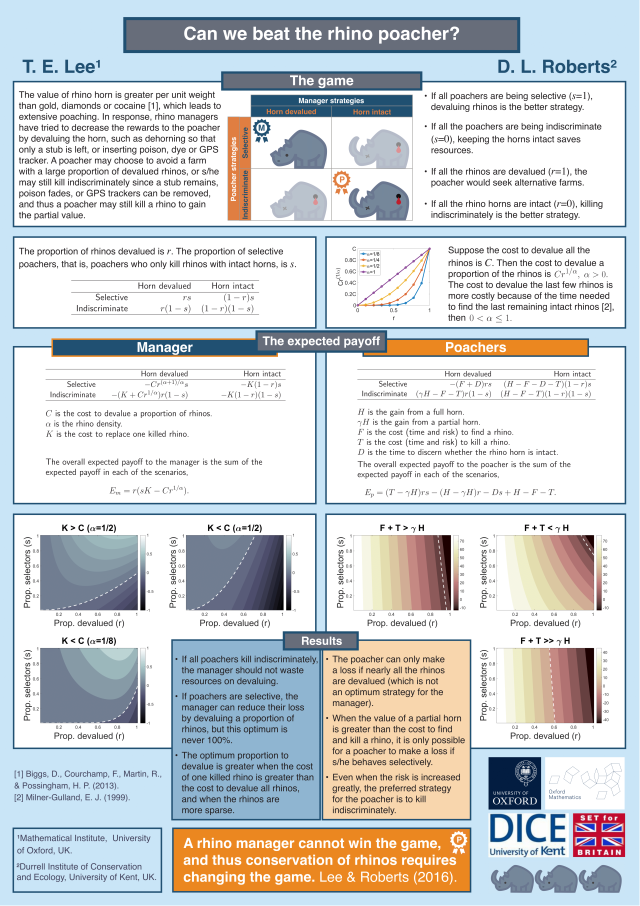tamsin.lee@swisstph.ch | tamsin.e.lee@gmail.com | @t_e_lee
I’m very happy to announce the publication of a paper I thoroughly enjoyed working on:
An evolutionary game theoretic model of rhino horn devaluation.
Nikoleta E. Glynatsi, Vincent Knight & Tamsin E. Lee
Ecological Modelling
The paper itself is nicely explained by the lead author Nikoleta E. Glynatsi, whose blog describes an earlier edition of the paper. Instead I’ll take on the easier task of explaining how this surprising topic came into my life because – well – Rhinos? I’ve already explained that I worked on electricity, and now I work on malaria. But rhinos!?!?
It all began…
At the University of Melbourne, in the Quantitative and Applied Ecology group, I worked on models to infer when an animal went extinct (how many years without seeing an animal is ‘too long’?). My first paper here was a collaboration of lots of people, including David Roberts (Durrell Institute of Conservation and Ecology, University of Kent), someone I didn’t meet during the creation of this extinction paper.
After this postdoc I move back to England. Of course, it’s worth making the trip from Oxford to Kent to meet this co-author. His office is AMAZING. There are animal parts and homemade dragons and books on everything interesting. Conversing with me was difficult as I developed ADHD in his office, continually interrupting to ask what different objects were.
David mentioned to me about dehorning rhinos to deter poachers. That is, when rhino owners humanly remove rhino horns (but a stub is left – like cutting finger nails), are poachers less likely to kill these rhinos? We discuss the idea of modelling the scenario using Game Theory: one player is a the rhino owner, and the other is the poacher. I didn’t have experience in Game Theory but it became one of those problems I couldn’t stop thinking about. What are the optimum strategies for each player? Do poachers want to kill any rhino irrespective of the horn length? Is it better for rhino owners to spend their limited resources on dehorning all rhinos, or spending some money on extra policing?
Hooked on quantifying the dynamics, pursuing this model was inevitable. The paper was published*, and I made a beautiful poster of it, with the help of Anna Huzar (who also made a 1 minute video for BBC3 about the topic). Armed with such a pretty poster, and a bit of luck, I was picked to present our poster at the Houses of Parliament for their STEM for Britain event.

At this event I meet yet another to-be-great-coauthor. Vince Knight (Cardiff University). He is an expert in Game Theory, and he talks about extending the model to include time and investigate the evolutionary stability. That is, if an equilibrium exists, can it be easily knocked out. So if all poachers are killing indiscriminately, what is the benefit of a new poacher only killing full horned rhinos? Or vica versa. Now, instead of poachers playing against rhino owners, they’re playing against each other in a world whose conditions are created by the rhino owner. What conditions make it difficult for poachers to make a gain by killing only dehorned rhinos, and thus making dehorning an effective deterrent?
And so began a new paper, led by Nikoleta E. Glynatsi, Vince’s PhD student. From here, I again refer to her blog for a description of an earlier edition of the paper. (Note that after excellent comments at the review stage, the paper has been improved to account for the time taken to a kill a rhino.)
Does dehorning work?
So that’s the back story. The work itself? In summary, the first paper with David shows that dehorning doesn’t work, and poachers will still kill rhinos for the remaining stub that is left. This new paper shows that dehorning can work, when implemented along with a strong disincentive framework – such as educational interventions. However, neither paper can stand alone in providing answers to the problem of rhino poaching. The topic is huge, and influencers range from local resources to global markets. This paper merely contributes to the discussion, and as always with research, it will hopefully provide a foundation for further models. And hopefully these new models will come about from equally enjoyable collaborations.
* Lee, T. E. & Roberts, D. L. (2016) Devaluing rhino horns as a theoretical game, Ecological Modelling, 337, 73-78.
tamsin.lee@swisstph.ch | tamsin.e.lee@gmail.com | @t_e_lee
